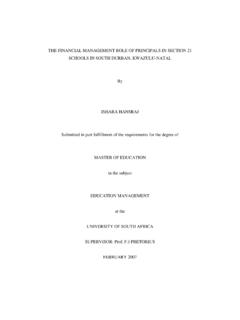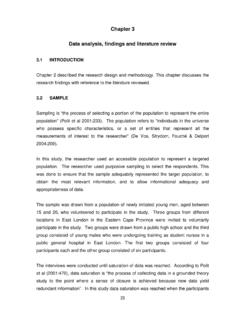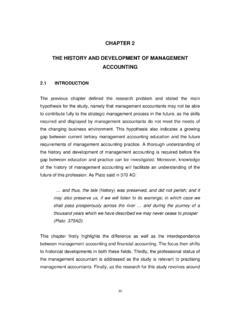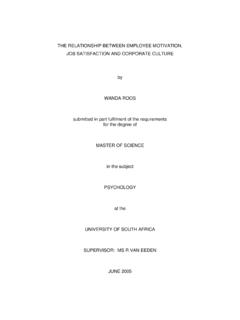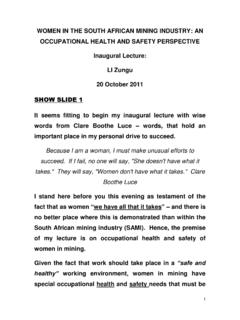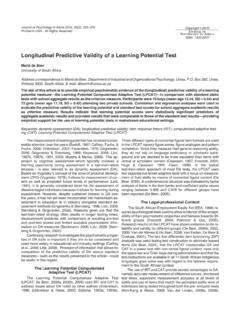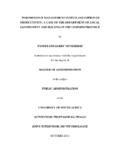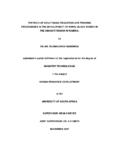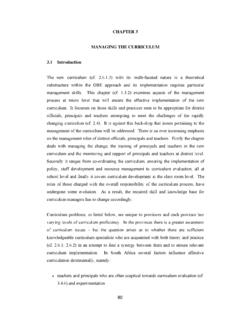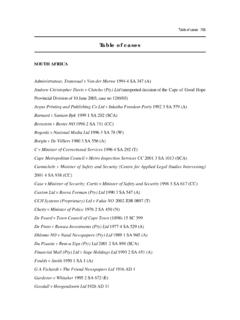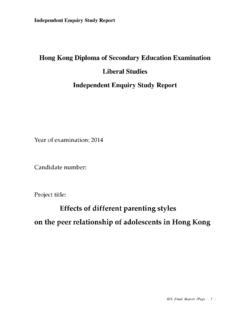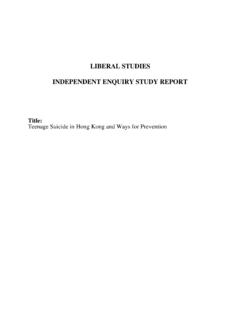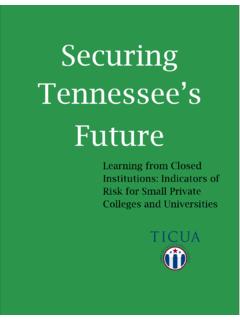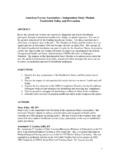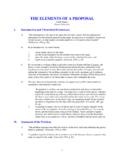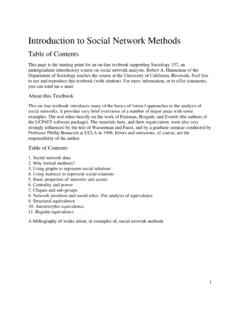Transcription of CHAPTER 5 PILOT STUDY 1. INTRODUCTION
1 256 CHAPTER 5 PILOT STUDY 1. INTRODUCTION The PILOT STUDY of the current research was the first step of the practical application of the Gestalt play therapy emotional intelligence programme for primary school children. It is also the last step of the first grouping of steps of an intervention research STUDY (De Vos, 2002:409-418) namely, Early development and PILOT testing . The three groupings of steps are presented visually in CHAPTER 1, Figure Research procedure. This CHAPTER covers a theoretical background of the definition and value of PILOT studies. It also covers the goal of the PILOT STUDY what the researcher expects from a PILOT STUDY . The researcher then discusses the application of the PILOT STUDY in the current research. The outcomes of the PILOT STUDY will also be discussed shortly, because these have a very direct influence on the actual research itself.
2 The researcher will first define a PILOT STUDY and state the value thereof following the INTRODUCTION to clarify what a PILOT STUDY really is and why it is needed in the research process. 2. DEFINITION OF A PILOT STUDY A PILOT STUDY is a mini-version of a full-scale STUDY or a trial run done in preparation of the complete STUDY . The latter is also called a feasibility STUDY . It can also be a specific pre-testing of research instruments, including questionnaires or interview schedules. (Compare Polit, et al. & Baker in Nursing Standard, 2002:33-44; Van Teijlingen & Hundley, 2001:1.) The PILOT STUDY will thus follow after the researcher has a clear vision of the research topic and questions, the techniques and methods, which will be applied, and what the research schedule will look like. It is reassessment without tears (Blaxter, Hughes & 257 Tight, 1996:121), trying out all research techniques and methods, which the researcher have in mind to see how well they will work in practice.
3 If necessary it can then still be adapted and modified accordingly. (Blaxter, Hughes & Tight, 1996:121) The PILOT STUDY in the current research can be defined as mainly a try-out of research techniques and methods, but also of questionnaires and interviews. The researcher compiled an emotional intelligence programme and applied this to a PILOT group of primary school children. During this process, the researcher also tested a short open-ended questionnaire on the cultures of the families of the children, questionnaires on their learning styles for the parents, a behaviour style instrument / questionnaire on the children in the PILOT group and feedback reports on these to the parents. The PILOT STUDY of the current research can therefore be defined as both a feasibility STUDY as well as a pre-testing of instruments, questionnaires and interviews. The value of first piloting the whole research process is discussed in the next section, because if a PILOT STUDY is of too little value, the researcher can waste time, energy and money.
4 3. VALUE AND GOAL OF A PILOT STUDY The researcher first discussed the value of a PILOT STUDY as stated by different authors and then the applicability to the current STUDY in the following paragraphs. After stating the value of such a STUDY , the researcher compiled the goal of a PILOT STUDY for the current research project. The Value of a PILOT STUDY Blaxter, et al. (1996:122) states that You may think that you know well enough what you are doing, but the value of PILOT research cannot be overestimated. Things never work quite the way you envisage, even if you have done them many times before, and they have a nasty habit of turning out very differently than you expected . It is thus very clear to the researcher, that the PILOT STUDY in the current research was essential to 258prevent the waste of time, energy and money. The value is also emphasised by the points listed below. According to Welman and Kruger (1999:146) many novice researchers are disillusioned when they find out that the guidelines for research are only valid in an ideal environment, and not in the practical research environment where they conduct their research STUDY .
5 This might be the main reason why a PILOT STUDY is needed. Welman and Kruger (1999:146) also listed the following three values of a PILOT STUDY : It is needed to detect possible flaws in measurement procedures (including instructions, time limits, etcetera) and in the operationalisation of independent variables. This value of the PILOT STUDY was very applicable in the current research STUDY . The researcher used two different measurement procedures with the research groups to gain information and to do a pre- and post test. The practical application of these in a group environment had to be piloted as well as the time to be allowed for each of these. Also the feedback structure to the parents had to be piloted to clear out practical difficulties, like duplication of information to parents, the need for the feedback and the time consumed by the specific format of feedback.
6 A PILOT STUDY is also valuable to identify unclear or ambiguous items in a questionnaire. Although the current STUDY did not make use of self-designed questionnaires for the pre- and post-test or for the behaviour style / personality assessment within the research process, piloting of the use of the existing tests was necessary. The items of the DISC behaviour style instrument were read to the group members. It was necessary to PILOT this action to clear out unclear items and also to determine time limits and the clarity of instructions. The latter two were already covered in the first point of value here. The non-verbal behaviour of participants in the PILOT STUDY may give important information about any embarrassment or discomfort experienced concerning the content or wording of items in a questionnaire. The latter could be valuable to a smaller extent in the current research, because this STUDY is not using a purely quantitative method, but a combined qualitative-quantitative method.
7 Children s reactions on the retest in a group format could be noted as well as their reactions on certain measurement situations during the group therapy process. The latter took place in the form of the DISC 259questionnaire to determine the children s processes and an exercise to determine their culture at home. The latter was not piloted in the PILOT group, but the need for this originated from the PILOT STUDY . The research process involved two groups. The culture exercise was thus tried out on the first group and could be adapted where needed for the use of the second group. This might also not be a very good example of the current value of PILOT studies, as this was an experiential exercise and not a questionnaire. Different children and groups, depending on their needs and processes, thus handled it in different ways. Other advantages of PILOT studies include the following as listed in Nursing Standard (2002:33,34): It can give advance warning about where the main research project can fail It indicates where research protocols might not be followed The PILOT STUDY can also identify practical problems of the research procedure It indicates whether proposed methods or instruments are inappropriate or too complicated Some of the advantage points listed above are relevant to the PILOT STUDY of the current research project.
8 The PILOT STUDY in the current research process was very specifically used to identify practical problems in the process, sessions and methods used. The research itself has as a goal the applicability of Gestalt play therapy techniques to enhance the emotional intelligence of primary school children in a cultural sensitive way. The PILOT STUDY could thus indicate whether the proposed methods and / or instruments are appropriate. The PILOT STUDY could thus also give advance warning of possibilities where certain types of techniques or the STUDY as a whole could fail. The PILOT STUDY can therefore be of value for testing the feasibility of both research instruments or data collection instruments like questionnaires, interview schedules, or other testing instruments and also of the research process itself. The following section combined the statements of the value of PILOT studies in a goal of PILOT studies in general as well as for the current research project.
9 The Goal of a PILOT STUDY The researcher sees the goal of a PILOT STUDY in general as related to the aim of the research project of which it forms part. The general goal of a PILOT STUDY is to provide information, which can contribute to the success of the research project as a whole. The latter is supported by the following quotes concerning the value and goal of PILOT studies: to see if the beast will fly (De Vos, 2002:410), reassessment without tears (Blaxter, Hughes & Tight, 1996:121), and Do not take the risk. PILOT test first. (Van Teijlingen & Hundley, 2001:2). The general goal thus seems to safe some time, effort and money, which can be lost if a major research STUDY fails because of unforeseen attributes. The goal is thus to test the STUDY on small scale first to sort out all the possible problems that might lead to failure of the research procedure.
10 It might minimise the risk of failure. In the current STUDY the goal of the PILOT STUDY consists of two parts. The first was to find as many as possible practical arrangements that might have a negative influence on the success of the research procedure. The other included sorting out all practicalities related to measurement instruments as well as the applicability of these instruments to the potential outcomes of the STUDY . The procedure of the PILOT STUDY in the current research project is discussed in the following paragraphs. 4. THE PILOT STUDY IN THE CURRENT RESEARCH PROJECT The PILOT STUDY of the current research follows the design phase, which is the research strategy as stated in CHAPTER 1, 8. RESEARCH DESIGN / STRATEGY. After the strategy is in place and the procedural elements of the intervention are determined (as far as possible), the early development and PILOT testing (De Vos, 2002:409) could follow.
